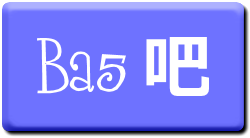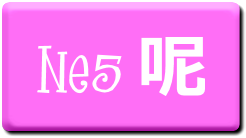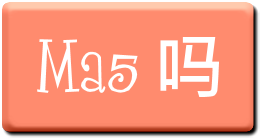Sentence-final particles are those helping words that occur at the end of a sentence and do not carry referential meaning, but they do serve some functions. Let’s focus on the differences of ba5 吧, ne5 呢 and ma5 吗, and you will understand them better when you encounter them next time when you speak and study your textbooks.
Ba5 吧– a modal particle (语气助词 yu3 qi4 zhu4 ci2) that indicates suggestion, command and permission.
1. Wo3 men5 kan4 dian4 shi4 ba5!
我们看电视吧。
Let’s watch TV.
2. Ni3 gei3 ta1 song4 dong1 xi5 qu4 ba5!
你给他送东西去吧。
You bring the things to him.
3. Ni3 jin4 lai2 ba5.
你进来吧。
You come in.
Ne5 呢 --
Function 1. Ne is added to a subject noun or a pronoun to ask follow up questions.
For example,
1. And you? –你呢? – ni3 ne5?
2. And her? – 她呢? – ta5 ne5?
3. And next week? -下星期呢? – xia4 xing1 qi2 ne5?
4. And this? – 这个呢? – zhe4 ge5 ne5?
How to answer this kind of subject noun + ne5 questions or pronoun + ne5 questions?
1. A. Xiao3 Wang2 ni3 hao3 ma5. B. Wo3 hen3 hao3, ni3 ne5?
A 小王你好吗? Little Wang, how are you?
B 我很好, 你呢? I am very good, and you?
Answer with yes: The answer to such a question usually includes 也 (ye3) – also, as in this example:
A. Wo3 ye3 hen2 hao3. 我也很好。 I am very good too.
Answer with no: Use bu4 不 or mei3 没 to negate the verb, or the adjective. (the verb you3 有 (have) can only be negated with mei2 没), see my other post about Chinese negation under Chinese grammar category.
For example:
A: Wo3 you3 hua1, ni3 ne5?
A: 我有花, 你呢?
A: I have flowers, and you?
B. Wo3 mei2 you3.
B. 我没有。
B. I don’t have.
or
A: Wo3 hen3 e4, ni3 ne5?
A: 我很饿, 你呢?
B. Wo3 bu2 e4.
B: 我不饿。
Ne5 function 2.
Ne5 can also be used as modal particles (语气助词 yu3 qi4 zhu4 ci2), used to express mood, or an expression of how a statement relates to reality and/or intent.
For example:
1 Ta1 mei2 lai2 ne5.
他没来呢。
He hasn’t come. or he did not come.
2.Ta1 hai2 shi4 bu4 shuo1 ne5.
他还是不说呢。
He still doesn’t want to say.
Ne5 function 3.
Ne5 is added to the end of sentence as question particle to form open-ended questions.
2. Xia3 jie3, ni3 yao4 chi1 shen2 me5 ne5?
小姐, 你要吃什么呢?
Lady, What you want to eat? (There are many answers for this question, so, we used ne5 呢, instead of ma5 吗.)
3. Xiao3 Liu2, ni3 ming2 tian1 yao4 zuo4 shen2 me5 ne5?
小刘,你明天要做什么呢?
Little Liu, What do you want to do tomorrow? (There are many answers for this question, so we use ne5)
Ma5 吗 — As question particle for non open-ended questions. Usually, it has only two answers, yes or no.
1. Zhe4 shi4 yi3 zi5 ma5?
这是椅子吗?
Is this a chair?
Answer 1. Shi4, zhe4 shi4 yi3 zi5.
是, 这是椅子。
Yes, this is chair.
Answer 2. Bu2 shi4, zhe4 bu2 shi4 yi3 zi5.
不是, 这不是椅子。
No, this is not chair.
2. Ni3 shi4 Wang2 xian1 sheng5 ma5?
你是王先生吗?
Answer 1. Shi4, wo3 shi4 Wang2 xian1 sheng5.
是,我是王先生。
Yes, I am Mr. Wang.
Answer 2. Bu2 shi4, wo3 bu2 shi4 Wang2 xian1 sheng5.
不是, 我不是王先生。
No, I am not Mr. Wang.




2 Responses to Chinese grammar – sentence-final particles 1- modal particle, question particle, question tag – the differences between ba 吧, ne 呢 and ma 吗 and grammar structure – how to use them